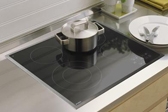
There are several very different options available to you when you’re choosing a cooktop. But how do they work, and what’s the difference? Find out how each style of cooktop performs in practical terms.

Because they heat the cookware rather than the cooktop surface, induction cooktops are safe to the touch. Image by ASKO.
One of the more vexing questions when you’re choosing appliances is deciding on what sort of cooktop (or ‘range’) you need. Generally speaking, you’ll need to decide between one of four options:
- Electric induction cooktop – Induction cooktops work using an alternating current to induce heat in the right kinds of cookware, and are safe to the touch.
- Gas flame burners – These burn gas to apply heat directly to your cookware.
- Electric ceramic radiant cooktops – These consist of coiled metal elements or halogen lamps which radiate heat from below through a tempered ceramic glass surface.
- Electric coil or solid hotplate cooktops – These cooktops are normally cheaper, and operate by running electricity through a resistive coil element or solid hotplate to heat cookware directly.
Most ranges will incorporate either two, four or six hotplates of various sizes using only one of these technologies, but other rangetops that provide a combination of these technologies (e.g. radiant and induction, or induction and gas) are also available.
How do induction cooktops work?
To appreciate why induction cooktops are considered ‘safer’ and why they’re becoming more popular, you need to understand how they create heat. Induction cooktops contain metallic elements under the cooktop surface. An alternating current is passed through these elements when the cooker is turned on, which oscillates back and forth through the elements.
This current doesn’t have any effect at all on most other kinds of materials – including human hands, but it does create an electro-magnetic field at the cooking surface. If your pots or pans are made from the right kind of metal, this field ‘induces’ an electrical current in base of the cookware you’re using. This electrical current in the cookware produces what’s known as ‘resistive heating’ – the pot or pan itself is heated, but the cooktop surface isn’t.
Some of the heat from the hot cookware you’re using will be transferred back into the cooktop surface, but this is normally made from a ceramic glass which is a pretty poor conductor of heat, so it shouldn’t stay too hot for too long.
What types of cookware work with induction cooktops?
To work with induction cooktops, your cookware needs to be ‘ferromagnetic’ – stainless steel or iron pots and pans work well, whereas aluminium doesn’t. An easy way to tell if your pots and pans will work on an induction cooktop is to see if they’ll stick to a magnet. If they do stick, they should work on your induction cooker.
If you already have a lot of non-ferrous cookware that won’t work on an induction cooktop, you still have options though. An induction disc (or ‘interface disc’ as it’s sometimes known) is a stainless steel disc that you can use on an induction cooktop to heat your incompatible cookware. These are normally quite inexpensive, and come in a range of different sizes.
Advantages and disadvantages of different types of cooktops
The best fit for your needs will depend on what sort of budget you have, what sort of fuel is available and to some extent, what kinds of foods you want to cook. Below are some of the advantages and disadvantages of gas, induction and other electric ranges:
Induction cooktops:
|
Advantages
|
Disadvantages
|
Electric coil or hotplate cooktops:
|
Advantages
|
Disadvantages
|
Electric ceramic radiant cooktops:
|
Advantages
|
Disadvantages
|
Gas burner cooktops:
|
Advantages
|
Disadvantages
|
How to choose a cooktop
Beyond considering the basic advantages and disadvantages of different cooktop technologies, there are a few key questions you need to answer to get the right cooktop. These include:
- Would a combination of gas, radiant, coil or induction cookers better suit your needs than just a single technology?
- How big is your family? If you have a large family or do a lot of cooking, six burners may be a better option than four.
- If you’re getting a gas cooktop, will you need or use a wok burner?
- What’s the warranty like?
- Is the brand / model well established and popular in Australia? If not, you may have a hard time with warranty claims and support (this goes as much for expensive European brands as any other).
- Will I need new cookware to go with a new induction cooktop?
- Will the style of my cooktop suit the style of my kitchen?





